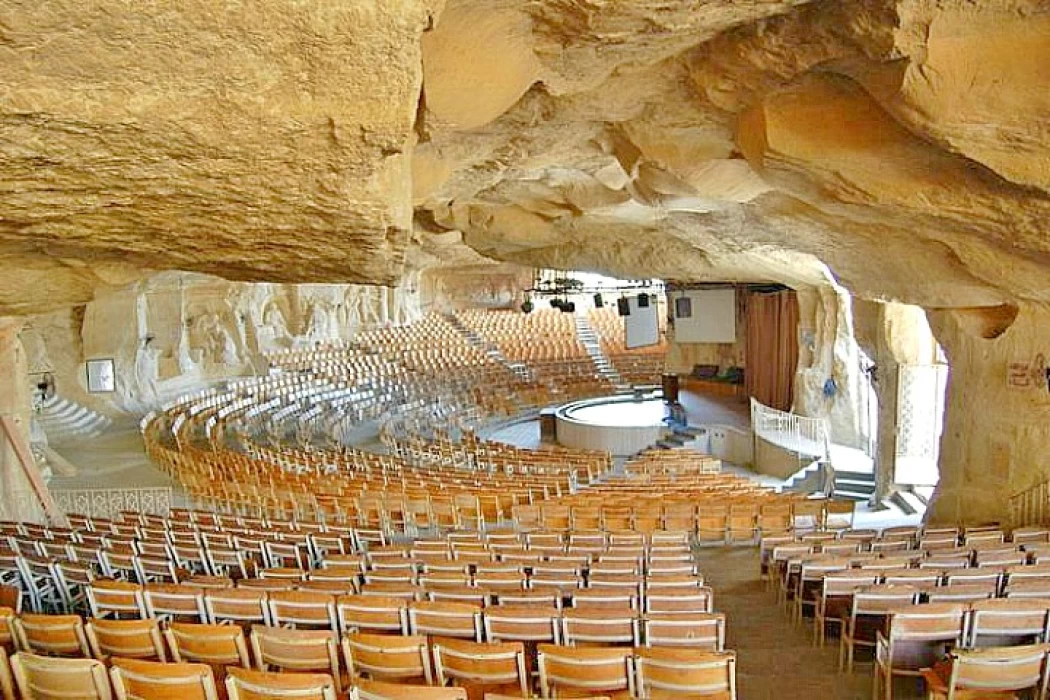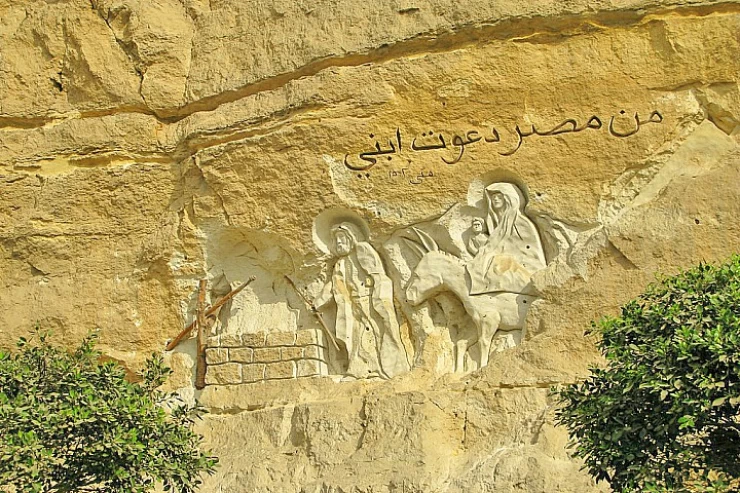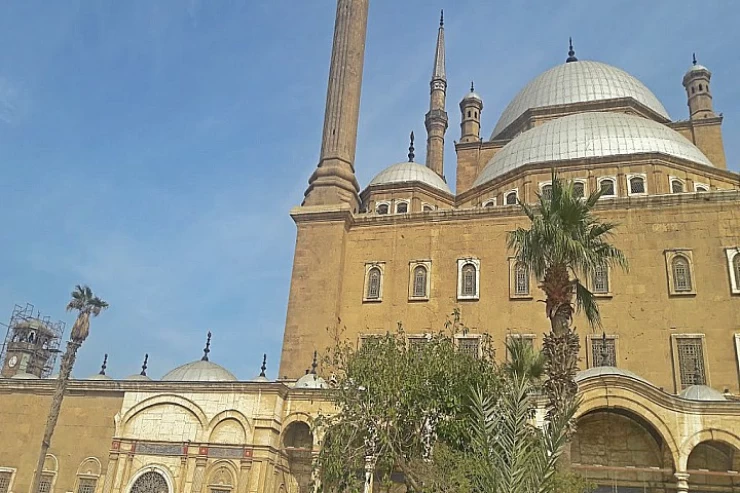
Monastery of Saint Simon The Tanner
The Monastery of Saint Simon the Tanner
Upon entering the Mokattam Mountain region and approaching the Abagya area, one is immediately drawn to a remarkable architectural marvel intricately carved into the heart of Mokattam Mountain: the Tanner Monastery. This site stands as a testament to the creative spirit of the mountain and has become a prominent destination for tourists from around the globe. The towering mountain harmonizes beautifully with the unique architectural style of St. Simon the Tanner Monastery, attracting a significant number of visitors each year.
Saint Simon
St. Simon the Tanner, a craftsman from the 10th century, is commemorated through this monastery, which is regarded as a significant attraction in Cairo. However, it is often overlooked in brief itineraries and day tours of the city. The cave church dedicated to him may not endure for much longer. Utilizing a pre-existing cave, the monastery can accommodate approximately 20,000 individuals around a central pulpit. Several caves have been transformed into distinct church spaces, collectively forming an extensive Christian complex within a city known for its waste. Each year, hundreds of thousands of pilgrims visit this monastery.
The principal church on the site is named in honor of the Virgin Mary and St. Simon, commemorating the miraculous event of the Mokattam Mountain's opening in November 979, for which Simon the Tanner was chosen to perform.
The churches of Coptic Egypt are essential sites for cruise passengers docking at various Egyptian ports. Our Egypt shore excursions can facilitate enriching experiences in Cairo during excursions from Sokhna port, or even if your stop is at another port, we can arrange visits through Port Said shore excursions.
Historians note that Ya’qub ibn Kulas, a Jewish minister serving under Caliph al-Mu’izz Ledin Ellah, held strong anti-Christian sentiments, while the caliph himself was well-versed in knowledge and literature. He extended an invitation to the Patriarch of the Copts to engage in a discussion regarding Jewish perspectives on religious matters, to which the patriarch responded, accompanied by Bishop Sawyros Ibn Al-Maqfa. During their dialogue, Bishop Sawyros accused the Jews of ignorance, referencing a passage from the Book of Isaiah: "The ox knows its owner, and the donkey its master's crib; but Israel does not know, my people do not understand!" (Isaiah 1:3). This provoked Ibn Kulas, who, along with a companion, sought to counter the Christians by scrutinizing their texts. His research led him to a verse in the New Testament where Christ tells his disciples: “If you have faith like a grain of mustard seed, you can say to this mountain, ‘Move from here to there,’ and it will move; nothing will be impossible for you” (Matthew 17:20).
Ibn Kulas presented this verse to the caliph, urging him to demand that the Christians substantiate the claims made in their scripture. This proposition intrigued the caliph, who was eager to eliminate the mountain located east of Cairo. Conversely, should the Christians fail to act upon the evangelical verse, it would serve as evidence undermining the validity of their faith. Al-Mu’izz dispatched a message to the patriarch, outlining his request and warning of severe repercussions should he fail, granting him a period of three days to comply. During this time, the entire church across the nation engaged in fasting and prayer.
The religious narrative concludes the tale by recounting the appearance of the Virgin Mary to the patriarch on the third morning. I instructed him to go outside and look for a man carrying a jar of water, who would be the chosen one to perform the miracle. Following the Virgin's directive, Simon encountered Kharaz and recounted the events. Kharaz then requested that the patriarch remain among the people on the designated day for the mountain's movement, during which he would lead the prayer while the patriarch marked the sign of the cross. This was executed as a significant earthquake transpired, causing the mountain to shift until the sun was obscured beneath it. Subsequently, Al-Kharaz fled to avoid receiving any accolades.
The construction of the Virgin Mary and St. Simon Cathedral occurred in two phases. Initially, it consisted solely of a vast limestone cave within the mountain. The second phase commenced in November 1994, coinciding with the feast of St. Simon. Fixed seating was arranged around the altar in a quarter-circle auditorium design, accommodating up to five thousand individuals, thus establishing it as the largest church within the Monastery.
Another remarkable church within the Monastery is St. Bola's Church, named in honor of St. Bola, the first Pilgrim, celebrated for his virtues. He resided in caves and solitude for seventy years, during which he never encountered another human being.
The Chapel cave was uncovered in 1986 during construction activities when a large rock fell, revealing an opening in the cave's ceiling. An intriguing incident involving this church occurred in January 1992 when it faced a fire ignited by an electrical spark. Remarkably, the image of Jesus Christ and the altar within the church remained unscathed, despite the extensive damage to the cave's interior.
The next notable site is St. Mark's Church, named in honor of St. Mark, the first evangelist, and recognized as the earliest church in Africa and Egypt. Additionally, there is St. Simon the Tanner's Hall, an impressive grotto constructed in 1979, featuring hundreds of tons of stone and reaching a height of 17 meters. The walls of this hall are embellished with exquisite carvings depicting various biblical scenes.
Furthermore, one can explore the intriguing Baron Empain Palace, situated in the bustling city of Cairo, Egypt.
A Hidden Gem in Cairo's Mokattam Hills .One of the most remarkable and beautiful historical places of worship is the Monastery of Saint Simon the Tanner, also known as the Cave Church, situated in the hilly, rocky Mokattam Hills of Cairo. Unlike the busy and crowded capital city of Egypt, this beautiful monastery does not only serve as a tranquil sacred space open to those who come in to seek the presence of God but rather possesses an exceptional view of walls sculpted into rocks forming the structure of the church. The very history of the place is almost more than ancient Coptic Christianity and the miraculous. For this reason, no matter how much in a hurry one is, a visit to this place is worth it for every religious lover wanting to explore Egypt’s religious mosaic.
The monastery is named after Saint Simon the Tanner, a Coptic saint from the 10th century who is most celebrated for a miracle during the rule of the Fatimid Caliph Al-Muizz. As per the Coptic tradition, it is said that during one of the reigns of the Copts, Al Muiz introduced a challenge to Pope Abram, the most senior leader of the Coptic Orthodoxy, to shift the Mokkatam mountain to illustrate that Christianity is true. After three days spent in prayers and fasting, Pope Abram had a vision of the virgin Mary, who asked him to look for Simon the Tanner. Simon, a simple leather craftsman who was very well connected with God, when the church gathered to pray, the mountain in question was raised, thus demonstrating the Christian religion to Al Muiz.
As a remembrance of this miracle, many centuries later, the large monastery compound in Mokattam was built in recognition of Saint Simon and the important event. At present, the monastery is also a monument to the Christian history of Egypt and the Christian context of the country.
The Monastery of Saint Simon the Tanner, which is located in the city of Cairo, is paradoxically quite remote. This monastery is located within Mokattam’s garbage city, wherein the Zabbaleen, are informal garbage cleaners of the city. The monastery, however, remains an island of peace amidst the turmoil. While the path to the monastery weaves through several narrow, twisting cores and squat buildings teeming with the city’s recycling activity, the view of the Cave Church’s gigantic rock-hewn altar is simply astounding.
The Monastery of Saint Simon the Tanner encloses an ensemble of several churches, each of exceptional interest: The most well-known and the one that leaves the greatest impression is The Cave Church, or, as it is more often referred to, The Church of Saint Simon the Tanner. This colossal area is hewn from the mountainside, making it the biggest church in the entire Middle East that can hold about 20,000 people. The inside of the cave is filled with religious images, paintings, and sculptures from the Holy Bible and the life of Saint Simon, which is all aglow with bright light coming from the rock ceilings. Above the cave, there are numerous cracks through which come rays of sunlight.
Within the compound, there are other notable churches such as:
The Church of Saint Mark: A compact but equally attractive church boasting soft stone carvings and quiet, contemplative areas for prayer and meditation.
The Church of Saint Bola: This church is also hewn from the rock and is cherished by tourists for its calm and peaceful interiors.
The Church of the Virgin Mary and St. Simon the Tanner: A congregation of faithful at a smaller church, where the churchgoers convene for daily masses and spiritual services.
Every church embodies a different spirit and embraces the beauty of nature along with the depth of spiritual culture.
The architecture of the Monastery of Saint Simon the Tanner is one of its most breathtaking features. The churches and spaces are not built conventionally but are hewed out of the rock of the Mokattam Hills. The use of natural, unprocessed limestone as the wall surfaces creates a rugged environment for the interior, allowing the guests to truly appreciate the ancient history of this place. This style of building also plays a part in enhancing the quality acoustic properties of the monastery, enabling the beautiful resonation of the Coptic liturgical hymns and chants all around the huge cave.
The outside view of the church complex is also exceptional. The corrugated grounds at the periphery of the monastery are embellished with high-relief sculptures and carvings that illustrate Biblical and Coptic cultural incidents. These high-stand carvings were done by a Polish sculptor, invariably hierarchy, thereby elevating the station of the site.
The Zabbaleen Connection
Over the last century, the Zabbaleen, a well-organized group of waste collectors or garbage collectors inhabiting the Mokattam region of Cairo, have had a very positive interaction with the Monastery of Saint Simon the Tanner. Most of the Zabbaleen are Copts, and like most communities in Egypt, they have suffered from troubles both social and economic. Nevertheless, a considerable part of this population has thrived in Garbage City through better integration of waste management and environmental services.
Though the purpose of the monastery transcends the physical boundary of the monastery, containing the Zabbaleen as it is, the monastery also offers hope and faith to these people. Some of the Zabbaleen assist in maintaining the monastery, and the place is important in their routine activity as a prayer and a meeting place. In addition to the monastery of Saint Simon the Tanner, a visit to the Zabbaleen's settlement reveals the extent to which their relentless work in recycling waste in Cairo went.
Religious significance and pilgrimage
The Monastery of Saint Simon the Tanner is a well-known place of pilgrimage for Coptic Christians not only in Egypt but also throughout the world. Many pilgrims primarily come to pray and meditate on the life and miracles of St. Simon. They seek inner healing and divine connection. The church also conducts regular services such as mass and other religious activities besides of the memorial services for Saint Simon, who is remembered annually on the 26th day of November.
















